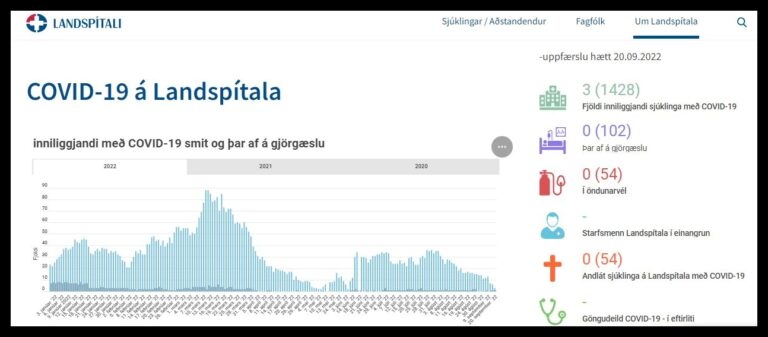So, maybe you thought that you had seen it all and that it couldn’t get any crazier.
Pfizer is planning to request FDA approval of yet another injectable product before the end of 2022.
This time, they are injecting pregnant women in the belief that it will pass along immunity to respiratory syncytial virus (RSV) to the unborn fetuses in their womb.
This is NOT safe. This is NOT effective. THIS IS EVIL.
A catastrophic vaccine failure that killed two toddlers could have been averted.
In 1966, a vaccine was tested in the United States against respiratory syncytial virus (RSV) — which infects almost all children before they turn two. The tests had dire consequences: Children weren’t protected; many infants still caught RSV, suffered worse symptoms than usual, and needed to be hospitalized; and two toddlers died as a result of enhanced disease symptoms. And a safe vaccine for the disease has still not been found.
Ultan Power, who works on RSV at Queen’s University Belfast, cautions: ”Because of what happened in the 1960s, there is a huge concern for anybody to take the first risk.”
https://www.nature.com/
AUTHOR’S COMMENTS:
- I ask the reader to take the time to review the details of this article, especially the Phase II study located just below the flashing red arrows. I hope that it will help you to gain a better insight into how the pharmaceutical industry hides incriminating evidence in plain sight.
- I cannot even begin to say how absolutely Pfurious I have become while researching this article. Pfizer’s blatant lies are so Pfucking obvious! I really hope that my readers can see through the massive psychological operation that is behind Pfizer’s latest attempt to turn a profit by injecting their Pformulas into unsuspecting mothers and their unborn children.
- The company (Pfizer) noted that the statistical success criterion was NOT met in the second main objective in a phase 3 trial in pregnant women who were given the vaccine to help protect their infants from RSV disease after birth.
- According to the CDC, RSV-associated deaths among children less than 5 years of age are thought to be uncommon, estimated at 100-500 per year. OPINION: I suffered from croup numerous times in my childhood. I know how bad it can be. I highly doubt that these children received optimal early treatment and I also highly doubt that they received optimal care if they were hospitalized.
- I have found nothing in any of Pfizer’s studies where Pfizer’s injectable concoction has been shown to save a single life from Respiratory Syncytial Virus.
- ThePfizer product has NOT been shown to be safe. It has NOT been shown to be effective. They are attempting to deceive everyone into assuming that their product has been shown to do something that it has NOT been shown to do. Does this sound familiar?
- LOOK AT THE CLINICAL ENDPOINTS OF THE STUDY. LOOK AT THE DATA AND REALIZE THAT THESE INJECTIONS HAVE NOT BEEN SHOWN TO SAVE LIVES! JUST LIKE THE COVID-19 VACCINES!!!
- The pharmaceutical industry’s business model is to damage your health so that you get sick in many other ways while they cherry pick data in the short term to claim that they are making you healthier, while they refuse to track the studies over the long term so that you cannot see the many ways in which these injections damage your health over the long term.
- Then they stop the study in the middle of a manufactured media frenzy and panic in order to promote a product for the future that cannot possibly help at the moment, BY DESIGN!
- A large percentage of pediatric hospital beds are Pfilled because they Pfired all the unvaxxed employees so there is a shortage of people to assign to those “beds” Please watch the videos at the bottom of this article, but please do not Pfall for their propaganda. This crisis and the propaganda that they are spewing out is Pfake as Pfuck.
- It sure would be nice if researchers would measure IgA responses when they are studying “vaccines” for respiratory problems. I’m just sayin’.
- As always, contact me directly at 310-619-3055 if you have any questions.
My humble requests for my readers and other researchers:
Pfizer refers to the injection as “bivalent” but, so far, I have been unable to locate any details that define what makes this injectable product “bivalent.”
Also, I cannot figure out what happened to the 6 infants that seem to have been unaccounted for in the PHASE II clinical trial. If you have any insight into the answer to why these 6 infants seem to be missing, please let me know.
https://clinicaltrials.gov/
I have not been able to obtain the detailed data from the PHASE III clinical study known as “MATISSE.” If you are able to obtain the detailed data from this study, please share it with me.
https://clinicaltrials.gov/
If you know these details, please share them with me: +1 310-619-3055.
PFIZER PFACTS:
Pfizer only released preliminary data regarding the PHASE III clinical trial on November 1, 2022. At this point, to my knowledge, they have not released anything other than propaganda. See below for details regarding the results of the PHASE II clinical trial.
- On November 1, 2022, Pfizer Inc. announced questionable data from their ongoing Phase III clinical trial (NCT04424316) MATISSE (MATernal Immunization Study for Safety and Efficacy)
- The study enrolled approximately 7.4K pregnant individuals who received RSVpreF or placebo during the late second to third trimester of their pregnancy. Think about that. Over seven thousand women volunteered to be in a study in which aluminum hydroxide could be injected into them while they were pregnant! Talk about “unfit for purpose.”
- The clinical trial is investigating Pfizer’s bivalent RSV prefusion vaccine candidate, RSVpreF or PF-06928316, which is administered to pregnant women in the belief that it will help protect their infants from RSV disease after their children are born.
- Pfizer stated that their “vaccine” involves injecting pregnant women with “a protein that is similar to RSV.” “During the MATISSE study, volunteers would receive one vaccination when they are between 24 and 36 weeks pregnant.”
- The study is designed to follow-up with the mothers and their infants for only 6 months after their birth.
- The relative risk reduction regarding severe RSV was only 69% after 6 months of life in the newborn infants. WOO HOO! By now, you should all realize that they are referring to the Relative Risk Reduction. They have not released the data by which one could determine the Absolute Risk Reduction. What they will likely ignore can be seen in my analysis of the data from the PHASE II trial seen below. Please take the time to review the dangers that the earlier, smaller study revealed.
- The PHASE II clinical trial is scheduled to end on November 12, 2023, but it seems like they may want to end it early in order to terminate the collection of data the way they did with the COVID-19 studies.
- Pfizer said that at the recommendation of a Data Monitoring Committee (DMC), and in consultation with the U.S. Food and Drug Administration (FDA), the company has stopped enrollment in the study.
- Pfizer intends to submit a Biologics License Application (BLA) to the FDA for respiratory syncytial virus infections by the end of 2022.
BACKGROUND INFO REGARDING RSV:
Respiratory Syncytial Virus (RSV) is RNA virus that is a member of the Paramyxoviridae family and is a major pathogen in the upper and lower respiratory tract in both infants and younger children.
Respiratory Syncytial Virus is not a systemic virus. It resides in the lungs, essentially outside the body, inside the space within your lungs along the border where the ciliated epithelial cells define the border between your body and the outside world. The battle against respiratory viruses is properly fought at this border and ideally involves the action of IgA (antibodies), among other immune system defenses.
Injecting a man-made, altered RSV protein and aluminum hydroxide into the bloodstream in order to improve the natural defense mechanisms that occur inside the lung at the epithelial border within the lungs is as ridiculous as doing that for COVID-19.
Injecting man-made, altered RSV protein and aluminum hydroxide into pregnant women is beyond ridiculous.
Respiratory syncytial virus manifestations include bronchiolitis, pneumonia and croup.
Progress on a vaccine for RSV almost came to a halt after an investigational vaccine failed in 1966. A formalin-inactivated RSV vaccine, which was being tested in the U.S., not only failed to protect children, but many infants experienced worse symptoms than usual, requiring hospitalization. Two toddlers died with enhanced disease symptoms, according to researchers.
“We tried an RSV vaccine in the 1960s, and things went sideways.”
RSV has multiple mechanisms of evading immunity, including
- Anatomical evasion is how RSV infects the superficial ciliated cells in the airway while not being systemic inside the body,
- Conformational evasion involves the virus’ F protein flipping from one neutralization-sensitive conformation to another,
- Direct modulation of immune function includes the NS1 and NS2 proteins interfering with interferon, an innate antiviral defense mechanism, whereas the G protein can bind dendritic cells and affect their function.
“RSV is the HPV of the respiratory tract. It infects the superficial epithelium of the airway and is even more superficial and protected from systemic immunity than HPV because its tropism does not include basal epithelium. …
The virus evades much of the systemic immune mechanisms by residing primarily outside the body.”
https://www.healio.com/news/
pediatrics/20180911/rsv- vaccine-development-about-to- enter-golden-age
The truth is hidden in plain sight.
The information below is taken from the PHASE II clinical study.
https://clinicaltrials.gov/
PHASE II TRIAL RESULTS:
In the Phase II study, researchers found that women who received RSVpreF vaccine containing aluminum hydroxide had a higher incidence of local reactions than those who received RSVpreF vaccine without aluminum hydroxide.
Yes, the injections contain aluminum hydroxide as an adjuvant.
579 pregnant women and 572 infants born to them participated in the study.
It seems like 1 of the 117 infants in the placebo group suffered fetal death and 6 infants in the “vaccinated” group are unaccounted for.
I am very curious about the status of the 6 unaccounted for infants.
BELOW IS DATA FROM THE PHASE II CLINICAL TRIAL SHOWING THE RISK OF ADVERSE EVENTS IN THE INFANTS AND THE PREGNANT MOTHERS.
The chances that infants whose mothers received the “vaccine” while pregnant would suffer from the diseases listed below was INFINITELY HIGHER (Relative Risk Ratio = infinity = division by zero) when compared to infants whose mother received the placebo.
NONE of the infants who were born to mothers who received the placebo while pregnant suffered from any of the adverse events listed below.
HOWEVER, THE ADVERSE EVENTS LISTED BELOW WERE EXPERIENCED BY THE INFANTS OF THE MOTHERS WHO RECEIVED THE INJECTIONS WHILE THEY WERE PREGNANT.
I do NOT consider this to be evidence of safety.
I consider this to be evidence of harm.
Naevus flammeus, candida infection, jaundice, abdominal pain, cardiac murmur, hypospadias (male), influenza, haemangioma, seizures, low birth weight, urinary tract infections, chordee, conjunctival haemorrhage, pharyngitis, umbilical granuloma, dermatitis contact, developmental hip dysplaysia, phimosis, neonatal respiratory failure, upper respiratory tract infections, bronchiolitis, acute respiratory failure, neonatal aspiration, conjunctivitis bacterial, folliculitis, viral upper respiratory tract infection, neonatal hypoxia, double ureter, sepsis, croup infectious, pneumonia, COVID-19, transient tachypnoea of the newborn, hypoglycemia, metabolic acidosis, mitral valve incompetence, cardiac murmur (functional), neutropenia, Alpers disease, congenital gastrointestinal disorder, chromosomal deletion, laryngomalacia, cleft lip, penile torsion, testicular retraction, polydactyly, spina bifida cystica, supernumerary nipple, vascular malformation, ventricular septal defect, gingival cyst, tongue cyst, intussusception, gastroenteritis salmonella, gastroenteritis viral, peripheral nerve palsy or skull fracture.
The relative risk ratio of infants suffering these adverse events was INFINITELY GREATER than the risk to infants whose mother received the placebo (divide by zero).
The trick of using small numbers: When a pharmaceutical company runs a very small study (this PHASE II trial is very small), they are then able to use the small integer numbers associated with the harm caused by their drug to trick people into thinking that the harms were small. To most people, one out of 500 (0.2%) seems like a small number, but when administered to millions of pregnant women (and their unborn children), the number of mothers and infants that could be permanently damaged becomes a substantially large number. Also, if the incidence of harm happens in one out of 501 cases, many potential harms are not revealed in such a small study.
Please realize that the pharmaceutical companies know exactly what they are doing.
Every one of the adverse events listed below is “evidence of harm.”
I have included hyperlinks to some of the less well known diseases.
Naevus flammeus
vaccinated (9/456) versus placebo (0/116)
19,737 per million infants
Candida infection:
vaccinated (8/456) versus placebo (0/116)
197,544 per million infants
Jaundice:
vaccinated (7/456) versus placebo (0/116)
15,351 per million infants
Abdominal pain:
vaccinated (7/456) versus placebo (0/116)
15,351 per million infants
Cardiac murmur
vaccinated (5/456) versus placebo (0/116)
10,965 per million infants
Hypospadias (male):
vaccinated (5/456) versus placebo (0/116)
OVER 10,965 per million male infants
Influenza:
vaccinated (4/456) versus placebo (0/116)
8,772 per million infants
Haemangioma:
vaccinated (4/456) versus placebo (0/116)
8,772 per million infants
Seizure:
vaccinated (3/456) versus placebo (0/116)
6,579 per million infants
Low birth weight:
vaccinated (3/456) versus placebo (0/116)
6,579 per million infants
Urinary tract infections:
vaccinated (3/456) versus placebo (0/116)
6,579 per million infants
Chordee (bent penis):
vaccinated (3/456) versus placebo (0/116)
OVER 6,579 per million male infants
Conjunctival haemorrhage:
vaccinated (3/456) versus placebo (0/116)
6,579 per million infants
Pharyngitis:
vaccinated (3/456) versus placebo (0/116)
6,579 per million infants
Umbilical granuloma:
vaccinated (3/456) versus placebo (0/116)
6,579 per million infants
Dermatitis contact:
vaccinated (3/456) versus placebo (0/116)
6,579 per million infants
Developmental hip dysplaysia:
vaccinated (2/456) versus placebo (0/116)
4,386 per million infants
Phimosis:
vaccinated (2/456) versus placebo (0/116)
OVER 4,386 per million male infants
Neonatal respiratory failure:
vaccinated (2/456) versus placebo (0/116)
4,386 per million infants
Upper respiratory tract infection:
vaccinated (2/456) versus placebo: (0/116)
4,386 per million infants
Bronchiolitis:
vaccinated (2/456) versus placebo (0/116)
4,386 per million infants
Acute respiratory failure:
vaccinated (2/456) versus placebo (0/116)
4,386 per million infants
Neonatal aspiration:
vaccinated (2/456) versus placebo (0/116)
4,386 per million infants
Conjunctivitis bacterial:
vaccinated (2/456) versus placebo (0/116)
4,386 per million infants
Folliculitis:
vaccinated (2/456) versus placebo (0/116)
4,386 per million infants
Viral upper respiratory tract infection:
vaccinated (1/456) versus placebo (0/116)
2,193 per million infants
Neonatal hypoxia:
vaccinated (1/456) versus placebo (0/116)
2,193 per million infants
Double ureter:
vaccinated (1/456) versus placebo (0/116)
2,193 per million infants
Sepsis:
vaccinated(1/456) versus placebo(0/116)
2,193 per million infants
Croup infectious:
vaccinated (1/456) versus placebo (0/116)
2,193 per million infants
Pneumonia:
vaccinated (1/456) versus placebo (0/116)
2,193 per million infants
COVID-19:
vaccinated (1/456) versus placebo (0/116)
2,193 per million infants
Transient tachypnoea of the newborn:
vaccinated (1/456) versus placebo (0/116)
2,193 per million infants
Hypoglycemia:
vaccinated (1/456) versus placebo (0/116)
2,193 per million infants
Metabolic acidosis:
vaccinated (1/456) versus placebo (0/116)
2,193 per million infants
Mitral valve incompetence:
vaccinated (1/456) versus placebo (0/116)
2,193 per million infants
Cardiac murmur (functional):
vaccinated (1/456) versus placebo (0/116)
2,193 per million infants
Neutropenia:
vaccinated (1/456) versus placebo (0/116)
2,193 per million infants
Alpers disease:
vaccinated (1/456) versus placebo (0/116)
2,193 per million infants
Congenital Gastrointestinal Disorder:
vaccinated (1/456) versus placebo (0/116)
2,193 per million infants
Chromosomal deletion:
vaccinated (1/456) versus placebo (0/116)
2,193 per million infants
Laryngomalacia:
vaccinated (1/456) versus placebo (0/116)
2,193 per million infants
Cleft lip:
vaccinated (1/456) versus placebo (0/116)
2,193 per million infants
Penile torsion:
vaccinated (1/456) versus placebo (0/116)
OVER 2,193 per million male infants
Testicular retraction
vaccinated (1/456) versus placebo (0/116)
OVER 2,193 per million male infants
Polydactyly:
vaccinated (1/456) versus placebo (0/116)
2,193 per million infants
Spina bifida cystica:
vaccinated (1/456) versus placebo (0/116)
2,193 per million infants
Supernumerary nipple:
vaccinated (1/456) versus placebo (0/116)
2,193 per million infants
Vascular malformation:
vaccinated (1/456) versus placebo (0/116)
2,193 per million infants
Ventricular septal defect:
vaccinated (1/456) versus placebo (0/116)
2,193 per million infants
Gingival cyst:
vaccinated (1/456) versus placebo (0/116)
2,193 per million infants
Intussusception:
vaccinated (1/456) versus placebo (0/116)
2,193 per million infants
Tongue cyst:
vaccinated (1/456) versus placebo (0/116)
2,193 per million infants
Gastroenteritis salmonella:
vaccinated (1/456) versus placebo (0/116)
2,193 per million infants
Gastroenteritis viral:
vaccinated (1/456) versus placebo (0/116)
2,193 per million infant
Peripheral nerve palsy
vaccinated (1/456) versus placebo (0/116)
2,193 per million infant
Skull fracture:
vaccinated (1/456) versus placebo (0/116)
2,193 per million infants
During their pregnancies, the women who received the injections reported the following adverse effects:
THE ADVERSE EVENTS LISTED BELOW WERE EXPERIENCED BY THE MOTHERS WHO RECEIVED THE INJECTIONS WHILE THEY WERE PREGNANT.
I do NOT consider this to be evidence of safety.
I consider this to be evidence of harm.
Injection site swelling, urinary tract infection, upper respiratory tract infection, dizziness, dyspepsia, GastroEsophageal Reflux Disease (GERD), abdominal pain, bacterial test positive, rash, cough, premature labour, non-reassuring fetal heart rate pattern, Vitamin D deficiency, syncope:, dyspnoea, vaginal hemorrhage, migraine, thrombocytopenia, hypertension, gestational diabetes, fetal growth restriction, headache, oedema peripheral, dehydration, vaginal infection, vulvo-vaginal injury, cellulitis, anorectal cellulitis, appendicitis, anemia, fetal tachycardia, anemia of pregnancy, blood loss anemia, cholecystitis, pyrexia, endometritis decidual, gastroenteritis, mastitis, oophoritis, osteitis, pyelonephritis, salpingitis, procedural hemorrhage, fetal heart rate decreased, fetal heart rate indeterminate, cephalo-pelvic disproportion, ectopic pregnancy, false labor, fetal hypo-kinesia, gestational hypertension, oligohydramnios, premature separation of placenta, prolonged rupture of membranes, retained placenta or membranes, influenza virus test positive.
Injection site swelling:
vaccinated (21/462) versus placebo (0/117)
45,455 per million pregnant women vaccinated
Urinary tract Infection
vaccinated (13/462) versus placebo (0/117)
28,139 per million pregnant women vaccinated
Upper respiratory tract infection:
vaccinated (10/462) versus placebo (0/117)
21,645 per million pregnant women vaccinated
Dizziness:
vaccinated (6/462) versus placebo (0/117)
12,988 per million pregnant women vaccinated
Dyspepsia:
vaccinated (5/462) versus placebo (0/117)
10,823 per million pregnant women vaccinated
Gastrooesophageal reflux disease (GERD):
vaccinated (5/462) versus placebo (0/117)
10,823 per million pregnant women vaccinated
Abdominal pain:
vaccinated (4/462) versus placebo (0/117)
8.658 per million pregnant women vaccinated
Bacterial test positive:
vaccinated (4/462) versus placebo (0/117)
8.658 per million pregnant women vaccinated
Rash:
vaccinated (4/462) versus placebo (0/117)
8.658 per million pregnant women vaccinated
Cough:
vaccinated (4/462) versus placebo (0/117)
8.658 per million pregnant women vaccinated
Premature labour:
vaccinated (3/462) versus placebo (0/117)
6,494 per million pregnant women vaccinated
Nonreassuring foetal heart rate pattern:
vaccinated (3/462) versus placebo (0/117)
6,494 per million pregnant women vaccinated
Vitamin D deficiency:
vaccinated (3/462) versus placebo (0/117)
6,494 per million pregnant women vaccinated
Syncope:
vaccinated (3/462) versus placebo (0/117)
6,494 per million pregnant women vaccinated
Dyspnoea:
vaccinated (3/462) versus placebo (0/117)
6,494 per million pregnant women vaccinated
Vaginal haemorrhage:
vaccinated (3/462) versus placebo (0/117)
6,494 per million pregnant women vaccinated
Migraine:
vaccinated (3/462) versus placebo (0/117)
6,494 per million pregnant women vaccinated
Thrombocytopenia:
vaccinated (2/462) versus placebo (0/117)
4,329 per million pregnant women vaccinated
Hypertension:
vaccinated (2/462) versus placebo (0/117)
4,329 per million pregnant women vaccinated
Gestational diabetes:
vaccinated (2/462) versus placebo (0/117)
4,329 per million pregnant women vaccinated
Foetal growth restriction:
vaccinated (2/462) versus placebo (0/117)
4,329 per million pregnant women vaccinated
Headache:
vaccinated (2/462) versus placebo (0/117)
4,329 per million pregnant women vaccinated
Oedema peripheral:
vaccinated (2/462) versus placebo (0/117)
4,329 per million pregnant women vaccinated
Dehydration:
vaccinated (2/462) versus placebo (0/117)
4,329 per million pregnant women vaccinated
Vaginal infection:
vaccinated (2/462) versus placebo (0/117)
4,329 per million pregnant women vaccinated
Vulvovaginal injury:
vaccinated (2/462) versus placebo (0/117)
4,329 per million pregnant women vaccinated
Cellulitis:
vaccinated (2/462) versus placebo (0/117)
4,329 per million pregnant women vaccinated
Anorectal cellulitis:
vaccinated (1/462) versus placebo (0/117)
2,165 per million pregnant women vaccinated
Appendicitis:
vaccinated (1/462) versus placebo (0/117)
2,165 per million pregnant women vaccinated
Anemia:
vaccinated (1/462) versus placebo (0/117)
2,165 per million pregnant women vaccinated
Fetal Tachycardia:
vaccinated (1/462) versus placebo (0/117)
2,165 per million pregnant women vaccinated
Anemia of pregnancy:
vaccinated (1/462) versus placebo (0/117)
2,165 per million pregnant women vaccinated
Blood loss anemia:
vaccinated (1/462) versus placebo (0/117)
2,165 per million pregnant women vaccinated
Cholecystitis:
vaccinated (1/462) versus placebo (0/117)
2,165 per million pregnant women vaccinated
Pyrexia:
vaccinated (1/462) versus placebo (0/117)
2,165 per million pregnant women vaccinated
Endometritis decidual :
vaccinated (1/462) versus placebo (0/117)
2,165 per million pregnant women vaccinated
Gastroenteritis:
vaccinated (1/462) versus placebo (0/117)
2,165 per million pregnant women vaccinated
Mastitis:
vaccinated (1/462) versus placebo (0/117)
2,165 per million pregnant women vaccinated
Oophoritis:
vaccinated (1/462) versus placebo (0/117)
2,165 per million pregnant women vaccinated
Osteitis:
vaccinated (1/462) versus placebo (0/117)
2,165 per million pregnant women vaccinated
Pyelonephritis:
vaccinated (1/462) versus placebo (0/117)
2,165 per million pregnant women vaccinated
Salpingitis:
vaccinated (1/462) versus placebo (0/117)
2,165 per million pregnant women vaccinated
Procedural haemorrhage:
vaccinated (1/462) versus placebo (0/117)
2,165 per million pregnant women vaccinated
Foetal heart rate decreased:
vaccinated (1/462) versus placebo (0/117)
2,165 per million pregnant women vaccinated
Foetal heart rate indeterminate:
vaccinated (1/462) versus placebo (0/117)
2,165 per million pregnant women vaccinated
Cephalo-pelvic disproportion:
vaccinated (1/462) versus placebo (0/117)
2,165 per million pregnant women vaccinated
Ectopic pregnancy:
vaccinated (1/462) versus placebo (0/117)
2,165 per million pregnant women vaccinated
False labor:
vaccinated (1/462) versus placebo (0/117)
2,165 per million pregnant women vaccinated
Foetal hypokinesia:
vaccinated (1/462) versus placebo (0/117)
2,165 per million pregnant women vaccinated
Gestational hypertension:
vaccinated (1/462) versus placebo (0/117)
2,165 per million pregnant women vaccinated
Oligohydramnios:
vaccinated (1/462) versus placebo (0/117)
2,165 per million pregnant women vaccinated
Premature separation of placenta:
vaccinated (1/462) versus placebo (0/117)
2,165 per million pregnant women vaccinated
Prolonged rupture of membranes:
vaccinated (1/462) versus placebo (0/117)
2,165 per million pregnant women vaccinated
Retained placenta or membranes:
vaccinated (1/462) versus placebo (0/117)
2,165 per million pregnant women vaccinated
Influenza virus test positive:
vaccinated (1/462) versus placebo (0/117)
2,165 per million pregnant women vaccinated
MATISSE STUDY PROPAGANDA:
MATISSE: MATernal Immunization Study for Safety and Efficacy
WEBSITE:
https://rsvvaccinestudy.com/
https://rsvvaccinestudy.com/
ABOUT RSV:
MATERNAL VACCINATION:
CLINICAL STUDY OVERVIEW:
https://rsvvaccinestudy.com/
ADDITIONAL PFIZER PFACTS:
- Pfizer has been conducting a clinical trial (NCT04424316) in which they have been injecting pregnant women with their RSVpreF “vaccine.” The study began June 17, 2020. The phase 3 study, dubbed MATISSE, evaluated the bivalent RSV prefusion vaccine RSVpreF (PF-06928316) against placebo to test efficacy against medically attended lower respiratory tract illness (MA-LRTI) and severe MA-LRTI in infants born to healthy women vaccinated during pregnancy.
- High level efficacy and adverse events data from a Phase-III clinical trials in Respiratory syncytial virus infections released by Pfizer on November 1, 2022.
- Pfizer will provide access to individual de-identified participant data and related study documents (e.g. protocol, Statistical Analysis Plan (SAP), Clinical Study Report (CSR)) upon request from qualified researchers, and subject to certain criteria, conditions, and exceptions. Further details on Pfizer’s data sharing criteria and process for requesting access can be found at: https://www.pfizer.com/
science/clinical_trials/trial_ data_and_results/data_requests - In a study in older adults, primary cohort participants were equally randomized to 1 of 7 RSVpreF formulations: 60 µg with either Al(OH)3 or CpG/Al(OH)3, 120 µg with either Al(OH)3 or CpG/Al(OH)3, 240 µg with either Al(OH)3 or CpG/Al(OH)3, 240 µg unadjuvanted, or placebo, administered concomitantly with high-dose seasonal inactivated influenza vaccine (SIIV) https://pubmed.ncbi.nlm.nih.
gov/35543281/
The primary endpoints to be reported in the MATISSE study are the following:
- The percentage reduction in the incidence of medically attended medically attended lower respiratory tract illness (MA-LRTI) due to RSV in infants through 180 days of life [ Time Frame: Delivery to 180 days after delivery ]
- The percentage relative risk reduction in the incidence of MA-LRTI due to RSV in the RSV vaccine group, relative to the placebo group will be assessed at specified time points in infant participants
- The percentage reduction in the incidence of medically attended severe LRTI due to RSV in infants through 180 days of life [ Time Frame: Delivery to 180 days after delivery ]
- The percentage relative risk reduction in the incidence of severe MA-LRTI due to RSV in the RSV vaccine group, relative to the placebo group will be assessed at specified time points in infant participants
- The percentage of infant participants with specific birth outcomes [ Time Frame: Birth ]Describe specific birth outcomes for infant participants
- The percentage of infant participants with adverse events (AEs) from birth to 1 month of age [ Time Frame: Up to 1 month of age ]Describe AE for infant participants from birth to 1 month of age
- The percentage of infant participants with serious adverse events (SAE) and newly diagnosed chronic medical conditions (NDCMCs) from birth to 12 months of age [ Time Frame: From birth up to 12 months of age ]Describe SAE and NDCMCs for infant participants from birth to 12 months of age
- The percentage of infant participants with serious adverse events (SAE) and newly diagnosed chronic medical conditions (NDCMCs) from birth to 24 months of age [ Time Frame: From birth up to 24 months of age ]Describe SAE and NDCMCs for infant participants from birth to 24 months of age
- Percentage of maternal participants reporting local reactions and systemic events from day of vaccination (Day 1) until Day 7 [ Time Frame: From day of vaccination until 7 days after vaccination ]Describe local reactions and systemic events after vaccination
- Percentage of maternal participants reporting Adverse Events (AE) within 1 month after vaccination [ Time Frame: Within 1 month after vaccination ]Describe adverse events (AE) after vaccination
- Percentage of maternal participants reporting SAEs [ Time Frame: From enrollment up to 180 days after delivery ]Describe serious adverse events from enrollment up to 180 days after delivery
SOURCES:
MATISSE (PHASE III TRIAL):
https://clinicaltrials.gov/
Pfizer Announces Positive Top-Line Data of Phase 3 Global Maternal Immunization Trial for its Bivalent Respiratory Syncytial Virus (RSV) Vaccine Candidate
Pfizer maternal RSV vaccine for infants
PHASE II TRIAL:
A PHASE 2B PLACEBO-CONTROLLED, RANDOMIZED STUDY OF A RESPIRATORY SYNCYTIAL VIRUS (RSV) VACCINE IN PREGNANT WOMEN
https://clinicaltrials.gov/
https://clinicaltrials.gov/
REDACTED DOCUMENTS:
https://clinicaltrials.gov/
RSV Prefusion F Protein-Based Immunization Studied in Pregnancy
https://www.drugs.com/news/
RENOIR
Study to Evaluate the Efficacy, Immunogenicity, and Safety of RSVpreF in Adults. (RENOIR)
RENOIR (RSV vaccine Efficacy study iNOlder adults Immunized against RSV disease)
https://www.clinicaltrials.
Pfizer Granted FDA Breakthrough Therapy Designation for Respiratory Syncytial Virus Vaccine Candidate for the Prevention of RSV in Older Adults
Safety and Efficacy of Bivalent RSV Prefusion F Vaccine in Adults ≥ 60 Years of Age
Respiratory Syncytial Virus (RSV) disease
Progress and challenges in the development of mRNA vaccines against respiratory syncytial virus
Development of mRNA vaccines against respiratory syncytial virus (RSV)
https://www.sciencedirect.com/
RSV vaccine development about to enter ‘golden age’
https://www.healio.com/news/
Prefusion F Protein–Based Respiratory Syncytial Virus Immunization in Pregnancy
https://www.nejm.org/doi/full/
CLINICAL TRIAL LOCATIONS:
https://clinicaltrials.gov/
Central Contact Person:
Pfizer CT.gov Call Center
Telephone: 1-800-718-1021
Email: ClinicalTrials.gov_Inquiries@
HEY PFIZER…
by James Roguski
The old system is crumbling, and we must build its replacement quickly.
If you are fed up with the government, hospital, medical, pharmaceutical, media, industrial complex and would like to help build a holistic alternative to the WHO, then feel free to contact me directly anytime.
JamesRoguski.substack.com/
JamesRoguski.substack.com/
310-619-3055
All content is free to all readers.
All support is deeply appreciated.
James Roguski’s newsletter is a reader-supported publication. To receive new posts and support my work, consider becoming a free or paid subscriber.
Um höfund

- Sigurlaug Ragnarsdóttir
- ✞༺(((( Ⓒilla ℜągnąℜṧ )))༻♚༺ BA Classical Art Historian || MA Culture & Media || Tourism & Sales Management || Web Design || Photo & Videographer for Tourism Magasins ༻
Síðustu færslur
 PROTECT THE CHILDREN23. nóvember, 2024BARNAMÁLARÁÐSTEFNAN 2024
PROTECT THE CHILDREN23. nóvember, 2024BARNAMÁLARÁÐSTEFNAN 2024 MANNRÉTTINDI19. nóvember, 2024MENNTASPJALL VALGERÐAR SNÆLAND JÓNSDÓTTUR
MANNRÉTTINDI19. nóvember, 2024MENNTASPJALL VALGERÐAR SNÆLAND JÓNSDÓTTUR Sigurlaug Ragnarsdóttir15. ágúst, 2024‘Really Chilling’: Five Countries to Test European Vaccination Card
Sigurlaug Ragnarsdóttir15. ágúst, 2024‘Really Chilling’: Five Countries to Test European Vaccination Card MANNRÉTTINDI9. ágúst, 2024Lög um borgaralega handtöku voru felld úr gildi árið 2008
MANNRÉTTINDI9. ágúst, 2024Lög um borgaralega handtöku voru felld úr gildi árið 2008












































